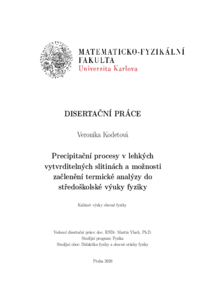Precipitační procesy v lehkých vytvrditelných slitinách a možnosti začlenění termické analýzy do středoškolské výuky fyziky
Precipitation processes in light hardenable alloys and the possibilities for integrating thermal analysis into physics education on high school
dizertační práce (OBHÁJENO)

Zobrazit/
Trvalý odkaz
http://hdl.handle.net/20.500.11956/120910Identifikátory
SIS: 177806
Kolekce
- Kvalifikační práce [10842]
Autor
Vedoucí práce
Konzultant práce
Stulíková, Ivana
Drozd, Zdeněk
Čížek, Jakub
Oponent práce
Černošková, Eva
Svoboda, Pavel
Fakulta / součást
Matematicko-fyzikální fakulta
Obor
Didaktika fyziky a obecné otázky fyziky
Katedra / ústav / klinika
Kabinet výuky obecné fyziky
Datum obhajoby
14. 9. 2020
Nakladatel
Univerzita Karlova, Matematicko-fyzikální fakultaJazyk
Čeština
Známka
Prospěl/a
Klíčová slova (česky)
Diferenční skenovací kalorimetrie, elektrická rezistometrie, (mikro)tvrdost, výukové experimenty, fyzikální vzdělávání, zábavná výukaKlíčová slova (anglicky)
Differential scanning calorimetry, electrical resistometry, (micro)hardness, educational experiments, physics education, edutainmentPředkládaná disertační práce je rozdělena do dvou částí - Termická analýza ve výuce SŠ fyziky a Materiálový výzkum slitin typu Al-Zn-Mg(-Cu-Sc-Zr). V rámci první části práce byly měřeny oblasti krystalizace, resp. tání vybraných potravin pomocí diferenční skenovací kalorimetrie. Byl vytvořen návrh nevšedního SŠ praktika z termodynamiky, který byl autorkou otestován na třech pražských gymnáziích. Praktikum bylo doplněno sepsáním vhodného studijního textu zaměřeného zejména na metodu diferenční skenovací kalorimetrie a její využití. Druhá část disertační práce je detailní analýzou teplotního vývoje fázových transformací v hliníkových slitinách typu Al-Zn-Mg(-Cu) se společným přídavkem příměsí Sc a Zr. Byl studován vliv deformace slitin (za studena a za tepla) a příměsí Sc, Zr na rozpadové řady a rekrystalizační chování těchto slitin. Ve slitinách AlZnMg(Cu)ScZr byla po izochronním žíhání do 360 řC prokázána přítomnost sekundárních částic Al3(Sc,Zr), které měly v těchto slitinách výrazný vytvrzující účinek při teplotách nad 300 řC. Ve slitinách AlZnMgCu byla po izotermickém žíhání na 350 řC/10 hodin pozorována částečná rekrystalizace, po žíhání na 450 řC/10 hodin byla velikost zrn 50-200 m (v závislosti na přípravě materiálu). Příměsi Sc a Zr stabilizovaly zrno, rekrystalizace slitin AlZnMgCuScZr nebyla v...
The doctoral thesis is divided into two parts - Thermal analysis in physics education on high school and Material research of Al-Zn-Mg(-Cu-Sc-Zr) alloys. Within the first part, the areas of crystallization and/or melting of selected foods were determined using differential scanning calorimetry. A practical lesson for high school physics has been created and tested. The study text focused mainly on differential scanning calorimetry and its use was made. In the second part of the doctoral thesis, there was analysed thermal evolution of the phase transformation in the Al- Zn-Mg(-Cu) alloys with Sc and Zr addition. The effect of (cold and hot) deformation on the decomposition sequences was studied. The hardening effect after annealing above 300 řC in the Sc and Zr alloys is caused by the precipitation of the secondary Al3Sc,Zr) particles. These particles were observed by transmission electron microscopy after annealing up to 360 řC in all studied AlZnMg(Cu)ScZr alloys. In the AlZnMgCu alloy the partial recrystallization was observed after annealing at 350 řC/10 hours and after annealing at 450 řC/10 hours the grain size was 50-200 m (depending on the treatment of the alloy). The addition of Sc, Zr in the AlZnMgCuScZr stabilizes grains and there is no recrystallization in the AlZnMgCuScZr alloy at temperature...
